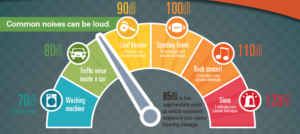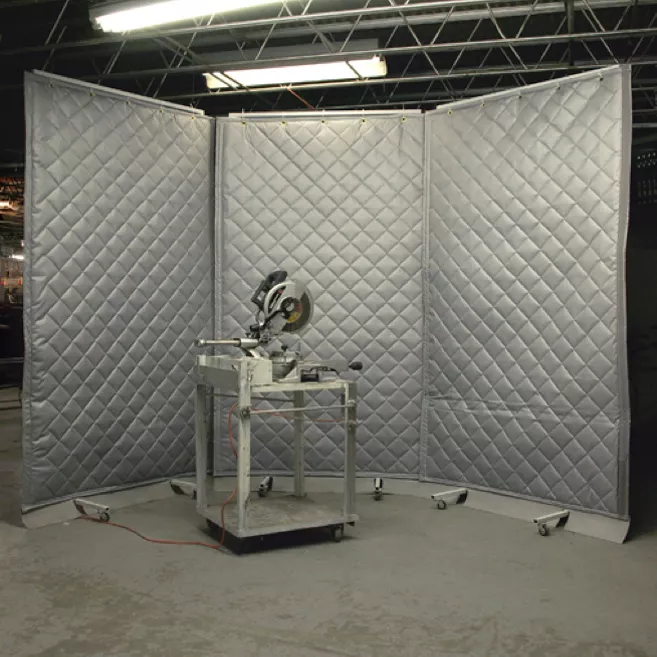American Made, Iron Clad Protected - Discover the Industries Best Warranty.

Blog
Dangers of High Noise Levels in Industrial Facilities

 22 million workers are exposed to potentially damaging levels each year. 85 decibels or higher can cause hearing loss, this also presents a distraction for workers that can result in other injuries. About 23,000 cases of occupational hearing loss were reported back 2007, A study found that between 1996 and 2010, 58% of workers experienced significant hearing loss due to high decibel sound exposures. Nearly 80% of welders suffered from hearing loss and 47% of roofers experienced NIHL. I a lot of these cases could hav been prevented by a PPE Noise Protection or specialty barriers to absorb or block sound inside facilities. Using sound deadening curtains, and Noise Ear Muffs sufficiently prevent loud noises from reaching the ear canal and causing NIHL. Here’s a closer look at the specific dangers associated with high noise levels in the workplace.
22 million workers are exposed to potentially damaging levels each year. 85 decibels or higher can cause hearing loss, this also presents a distraction for workers that can result in other injuries. About 23,000 cases of occupational hearing loss were reported back 2007, A study found that between 1996 and 2010, 58% of workers experienced significant hearing loss due to high decibel sound exposures. Nearly 80% of welders suffered from hearing loss and 47% of roofers experienced NIHL. I a lot of these cases could hav been prevented by a PPE Noise Protection or specialty barriers to absorb or block sound inside facilities. Using sound deadening curtains, and Noise Ear Muffs sufficiently prevent loud noises from reaching the ear canal and causing NIHL. Here’s a closer look at the specific dangers associated with high noise levels in the workplace.
Hearing Loss
The most obvious harm that loud noises can cause is loss of hearing. Sound levels at 85 decibels or greater can cause irreversible ear damage to workers without realizing it until it’s too late. The Occupational Safety and Health Administration (OSHA) recommends that exposure to sound levels of 90 dBA be kept to eight hours or less to avoid hearing damage. They also recommend that employees avoid daily exposure of more than 15 minutes to noises reaching 100 dBA.
Hearing Protection
Ear protection in the form of over-ear muffs or earplugs is recommended. Hearing protection will have a Noise Reduction Rating (NRR) rating to tell you the number of decibels it reduces sound by. The level of noise reduction varies by product but usually ranges from 20-33 decibels. An NRR of 33 decibels also does not mean that the employee’s exposure will drop by 33 dB. The label is misleading with the actual formula being:
Noise reduction = (33-7)/2 = 13
If you are exposed to a 100 dB sound source while wearing hearing protection that has an NRR of 33 dB, your new exposure would be 87 dB, not 67 dB. Combining hearing protection also does not stack the numbers. Wearing two forms of hearing protection will lower your exposure by 4-8 dB, added onto the highest rating of the two forms of protection. This protection is also dependent on properly wearing your hearing protection. If you fail to wear the protection properly, the protection may be reduced to almost zero.
Equipment Damage
Reverberations from loud noises can cause vibrations that dislodge equipment or cause it to fall off of surfaces, potentially causing hundreds to thousands of dollars of damage to machinery. This can also cause harm to nearby workers who don’t have time to react. Items that are in a high noise area need to be strapped down more carefully and inspected regularly.
Distractions and Decreased Productivity
Another potential danger with loud industrial noise is a high level of distraction. If high noise levels bother employees, they may not be able to focus as well on their tasks, reducing overall productivity. It takes people 25 minutes to recover from distractions and gain previous levels of productivity. That includes tiny distractions that take up almost no time. Distraction can also result in mistakes that may cause harm to workers. The vast majority of accidents happen because of distraction and neglecting safety. Reducing noise levels allows employees to work undistracted and can further, improve workplace safety.
Using Sound Reducing Curtains
Sound deadening curtains are an effective and relatively inexpensive solution for issues regarding high noise levels. Employees are able to function normally and can avoid having to deal with as much PPE as they would in an unrestricted environment. Unlike permanent wall constructions, they’re ideal for applications requiring temporary closing off of specific spaces, while allowing employees to change configurations based on changing the workspace layouts.
Ultimately, using heavy-duty sound reducing curtains can keep employees from harm and equipment protected from damage.
Steel Guard Safety Sound Deadening Curtains
Create a fully customized soundproof curtain system with the many options we provide. Our curtains are constructed with five layers of waterproof and chemical-resistant vinyl and fiberglass materials, with a flexibility that allows workers to move curtains in and out of the way simply. Choose from multiple types of roller track systems to create small work cells or large divided work areas within a facility. Our curtains are also available with PVC work-view windows that are as soundproof as completely opaque models, giving employees visibility in work areas.
Quality curtains make a difference. You want that perfect blend of performance and durability. The quilted vinyl front protects the curtains from getting damaged while the fiberglass batting effectively absorbs sound. It isn’t just the material that absorbs sound either. The texture and shape of curtains specially designed to absorb sound make them even more effective. Noise levels can be reduced by as much as 61 decibels for certain frequencies.
Contact Steel Guard Safety for more details about our sound deadening curtain products, and we’ll help you start designing a curtain system that’s suitable for your facility. If you would like curtain walls for protection in welding environments, temperature-sensitive warehouses, or other types of industrial facilities, we also offer industrial curtain wall solutions for these applications. Each of our curtain wall products are easy to install, and we provide warranties as well.

Recent Posts
- Industrial Curtain Walls: 6 Reasons Why Manufacturing Facilities Must Have Them
- Industrial Soundproof Curtains: How to Decide Between Floor-Mounted and Ceiling-Mounted Curtains
- How to Transform a Noisy Open-Plan Office with Acoustic Baffles
- A Guide to Choosing the Best Concrete Blanket for Construction Projects
- Porch Curtains: 8 Amazing Reasons to Install These Curtains in Your Home
- Chemical Splash Curtains and Their Applications in Different Industries
- Outdoor Sound Curtains for Farms and Animals
- Construction Sound Barriers: Why Every Construction Site Should Have These?
- Industrial Blackout Curtains and Their Applications in Different Settings
- Sound Curtains for Industrial Use: How to Buy the Right One
Categories
- Accordion Fold Curtains
- Acoustic Baffles
- Agri-Shield Curtains
- Auto Body Shop Curtains
- Bio Plastics
- Industrial Divider Curtains
- Industrial Safety Products
- Insulated Curtain Walls
- Machine Guard Safety Fencing
- Mesh Curtain Screens
- Outdoor Curtains
- PVC Strip Curtains
- Soundproof Noise Blocking Curtains
- Spray Paint Booth Curtains
- Tarps
- Thermal Curtains & Covers
- Uncategorized
- Warehouse Dividers
- Welding Blankets
- Welding Curtains
- Welding Screens


